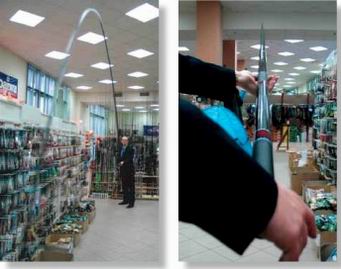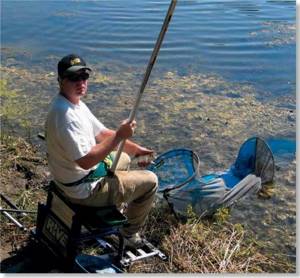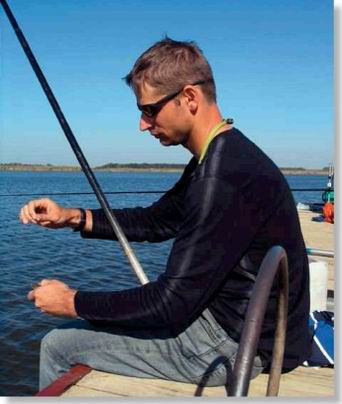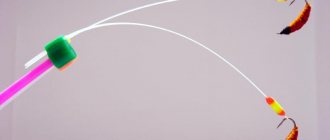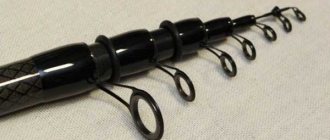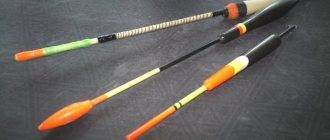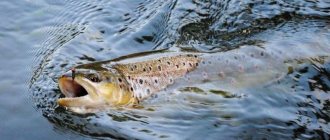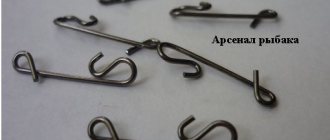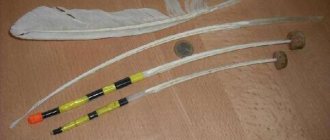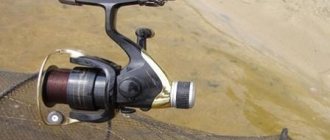Alexander Dunaev, “Fisherman's Compound”
The majority of fishermen begin their careers by mastering a float rod. Today, there are several varieties of this tackle: “plug”, “flying rod”, “Bolognese” and “English” or “match”. One of the most important distinguishing features of each of them is the design of the fishing rod. They differ in the way the knees are connected, the thickness of the walls, the material, the presence or absence of rings, and much more. However, despite such diversity, almost everyone starts with the simplest and most “democratic” design - a “fly” fishing rod or “fly”. That is why the selection of articles in our magazine for beginner floaters opens with this topic.
| The summer float season of 2004 was marked by a number of interesting events: firstly, a ban on the use of float rods longer than 13 m during competitions, which, of course, played into the hands of lovers of fishing with classic fly rods; secondly, at the next Russian Championship in fishing with a float rod, the use of the “mach” became successful for some of our athletes. Just remember Maxim Kusmartsev, whose performance on the first and second days of the competition brought him third place in the individual competition. Other famous fishermen were also seen with fly rods - Sergey Fedorov, now a three-time champion of Russia, Evgeny Sereda and others... |
| More than fifteen years of experience in participating in various competitions allowed these athletes to master fishing first with “fly” rods, then with long “plug” rods. It is not surprising that after the Russian Championship many anglers felt the need to master swing fishing. For fans of float fishing who are not involved in sports, rods with blind rigging are simple, affordable gear that does not require significant financial expenditure. This is the main reason for its popularity. But first, let's talk about the main characteristics of fly rods, which you should pay special attention to when purchasing. |
|
RODS BUILDING
| It is difficult to give a clear definition of the concept of “action” for a fishing rod. Let's agree that by "tuning" we mean the bending curve under load. A rigid rod has a fast action - the whip bends and one or two knees following it. Soft, with a slow action, characterized by a longer length of the part of the rod that bends under load. The catalogs of global manufacturers of fishing products include both hard and soft fishing rods. There are no clear criteria that allow classifying a particular product as hard or soft. It's like my professor's favorite joke, who asked the audience how many people make up a crowd? They told him different numbers; at the end of the argument, stopping at the number two, he slyly asked, what if the crowd consists of women? Human perception is individual. A rod that seems fast to me may seem medium-fast to another angler. I classify various rod models into one group or another, based on my own understanding of rigidity (action). |
|
Why is it necessary to produce “flying” rods of different construction? Let's not forget that the action determines the characteristics of the rod's performance. For example, slow ones allow you to carefully remove large or small fish, reducing the likelihood of them running off and breaking a thin leash. They cast light rigs well with a small float carrying capacity. I would recommend these to beginner fishermen and amateurs. Their disadvantages include low efficiency during accelerated fishing. They are not able to quickly pull a fish weighing 100 g out of the water.
Fast-action rods are a little rough when landing fish, but they allow you to make a brilliantly short hook that protects the thin leash: often the reason for the hook is the cutting of the soft tissues of the fish’s mouth by the hook - the so-called “knocking out” of the hook.
Rods of this type are worse at casting light equipment, but at the same time, in high-speed fishing situations, time is not wasted on prolonged fatigue of the prey. Manufacturers combat this undesirable effect by incorporating a soft whip into the rod.
I would recommend fast action rods to competition athletes, especially when they need to land fish faster.
In the store, the action can be determined by comparing the bending amplitude of a couple of disassembled rods under the load on the tip of the whip.
Choosing the right fly rod
Experienced fishermen often argue about how to choose the right fly rod. At the forefront of these disputes is the length of these forms. Some people prefer to take the longest options, others believe that the best and most comfortable fly rods are medium length. Everyone is right in their own way, but still, choosing a fly rod is a creative process that must take into account many parameters of fishing conditions, on which the characteristics of the rod itself depend.
Like most fishing sticks, blanks of this type differ in the following main parameters:
- Rod length;
- Test;
- The material from which it is made;
- Build.
Let's look at each of these parameters in more detail in order to understand how to choose the most suitable fly rod.
Form length
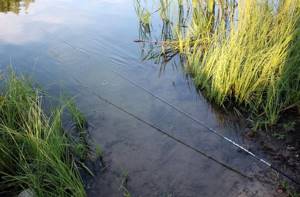
Flying rods range in length from 3 to 11 meters . The boundaries are quite wide, so experts in fishing with this gear divide them into conditional categories depending on length:
- Length from 3 to 5 meters. These forms are designed for catching small fish at short distances. The best option for fishing from a boat.
- Length from 5 to 7 meters. This is the most universal and widespread category. Used for catching medium-sized specimens, up to 2 – 2.5 kg. Suitable for fishing in still water and small currents.
- Length from 7 to 9 meters. Such forms are not that common. Used when long distance casting is required. If the angler does not have sufficient experience in using such gear, it is better not to use a fly rod 7 meters or longer. It's better to take a slightly shorter option.
- Length 9 meters or more. These are very rarely used rods. Used only by professionals for precise casting of bait over long distances.
It is rational for the fisherman to have forms of various lengths, for example 4, 7 and 9 m . And the optimal length of the fly rod that will be used is usually determined at the fishing site.
Test
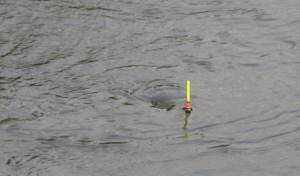
The blank test shows the permissible weight of all equipment that can be used on it without fear of damaging or breaking it. Indicated in the form of certain numerical values indicating the upper and lower limits of permissible weight in grams. For example, numbers 4 – 12 indicate that this form is designed to work with equipment weighing from 4 to 12 grams .
For fly rods there is an unwritten rule : with a rod length of 5 meters, the weight of the equipment must be at least 5 grams, respectively, for a 7 meter rod this figure must be at least 7 grams.
Material of manufacture
The material of manufacture is, first of all, the weight of the fishing rod, as well as its strength and elasticity. Modern fly rods are made mainly from two materials:
- Fiberglass.
- Carbon fiber (carbon fiber) , which belongs to the category of composite materials.
Fiberglass fishing rods fall into the budget category. They have good strength, but are heavy and often lose their characteristics, or even break, after just a few fishing trips. The best budget fly rods cost about one thousand rubles. Designed for beginner anglers to hone their skills.
Carbon fiber forms are much more expensive, but have many advantages over fiberglass ones. The main one is that they are much lighter. For example, the best fly rods 7 meters long weigh no more than 210 - 240 grams with a diameter at the base of the butt of only about 4 centimeters. The only negative is that they require careful handling and do not like shock loads. After each fishing, they must be cleaned of sand and adhering dirt.
Build
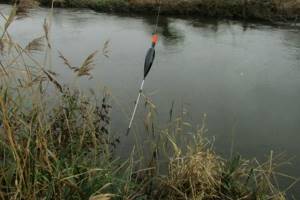
If you plan to catch small fish (bleak, roach, dace, etc.), then a fishing rod with a fast or medium-fast action . With such forms, under load, the upper third bends first.
To catch larger fish, choose medium action rods . Their initial bending occurs in the upper half of the length. Such forms are the most versatile, allow you to work perfectly with the appropriate equipment, and are applicable in most cases.
Slow action forms (bending occurs approximately along its entire length) are used for catching large fish. They are not very convenient when biting small and medium-sized fish, since the hooking is too rough.
Another important characteristic of this type of fishing rod can be considered the number of segments that make it up. The length of each segment determines the length of the rod when folded, which is important when transporting it.
Expert opinion
Knipovich Nikolai Mikhailovich
Zoologist, hydrobiologist. I am interested in fishing at a professional level.
Attention! The shorter the knee components, the more of them you will need for the rod, the less balanced the blank will be, which will negatively affect the sensitivity of the tackle.
The most rational is the number of segments equal to the length of the rod. That is, if the length of the form is 7 meters, then it should consist of 7 legs.
RODS POWER
| By this term we mean a margin of safety. Sometimes, due to inexperience, power is confused with rigidity, understanding the latter not as structure, but as the load necessary for bending. A powerful, difficult-to-bend rod can not only work under enormous loads, but also has a soft, slow action. Conversely, hard fishing is only suitable for ultra-thin rigs and delicate fishing. Power directly determines fishing characteristics such as load. The load is not only the absolute size of the fish, but also the nature of its resistance, the style of fishing, the possible presence of interference and the careful care of the tackle. The less time the fisherman spends on caring for the tackle, the more powerful the purchased product should be. Only from a powerful rod can you make several shorter ones without the risk of crushing your knees while fishing. |
|
A few words about the leash
The leash allows you to more delicately present the bait to the fish, and also preserve the tackle when hooking. Therefore, the leash is made from a thinner fishing line than the main one. The running diameters of the leading line are 0.1-0.12 mm, for carp fishing - 0.15-0.2 mm. The usual leash length for a fly fishing rod is 15-25 cm; the hook is selected taking into account the expected size of the fish and the bait used, the most popular sizes are No. 10-16.
It is better to make leashes and rigs at home, so as not to waste precious time fishing. Finished equipment is stored and transported on reels, on the side surface of which it is worth writing down with a marker the diameter of the main fishing line, the carrying capacity of the float and the length of the rod for which the equipment is intended.
RODS TIP
| The performance characteristics that determine the process of landing fish are largely related to the softness and elasticity of the whip. Taking this fact into account, manufacturers make thin rod tips with a diameter of up to 0.6 mm. In a fight with a large fish, one of the middle legs is more likely to break than the tip. I know that many anglers are not able to buy an expensive quality fishing rod. Cheap models made in China or Korea are quite suitable for fishing with thin lines, but will require significant modifications. As a rule, they have a thick and powerful whip, which does not allow you to control the process of fishing with thin fishing lines. It is this that should be replaced first. On sale I have come across some good carbon plastic whips that cost only 100-150 rubles. |
|
BUT DIAMETER
In windy weather, fishing with long but light rods can be significantly difficult due to increased stress on the lower and middle knees. Manufacturers often try to change the structure of “fly” rods by increasing the diameter of the butt, but these changes can negatively affect fishing in difficult weather conditions, increasing windage by 20-30%. For me personally, the solution to this problem is very simple - when the wind is strong, I don’t go fishing. However, there are many anglers who are extreme sports enthusiasts. If you are one of those, then I advise you to pay attention to rods with a smaller butt diameter.
RODS WEIGHT
It is impossible to say with certainty that it is the mass that should become the cornerstone when choosing a fishing rod for amateur fishing.
My first serious rod, a ten-meter Phantom, had about a kilogram of carbon fiber, and I swung it quite briskly for 8-10 hours in a row. The “Maver 234” model, weighing less than a feather, broke on my very first fishing trip, although the previous “mach” did not have a single scratch for many years. Remember, the lighter the rod, the higher the likelihood of it breaking!
The weight of the rod also depends on the grade of graphite. The wall thickness may remain the same, while the weight decreases, but these changes certainly affect the increased price of the product.
Believe me, during competitions, it is not the owner of a lighter and more expensive fishing rod that wins, but the angler who knows how to use it correctly.
For amateur fishing, you should not choose very thin-walled models, because... the likelihood of them breaking is too high. “Workhorses” will do just fine, even if they are several tens of grams heavier.
While fishing with some “fly” models, I made one interesting observation. So, with the same mass of two fishing rods of equal length, you may get the feeling that one of them is heavier. This is due to a shift in the center of gravity to the whip due to heavier middle knees and lighter upper ones.
Now that we have discussed the concept of action, power and weight of a fishing rod, let's look at the principles of selection taking into account the upcoming fishing conditions.
Pros and cons of a fly rod
There are several advantages of fishing with blind rigs. The main thing for a novice fisherman is the simplicity of the gear, and therefore the ease of mastering it. Further, we can note the compactness and mobility of the fly rod. Everything you need for fishing will fit in your windbreaker pocket, and its mobility will allow you to actively move around the pond in search of fish. And the ability to select equipment for various fishing conditions, be it a pond, a lake, a small or wide river, or a reservoir, makes this type of fishing also universal. Having made several different equipment in advance, you can assume with a high degree of confidence that one of them will be suitable.
There are also implicit advantages. First of all, these are very small costs for high-quality, catchable tackle.
The disadvantages of fishing with a fly rod include a fixed fishing range, limited by the length of the rod and fishing line of approximately equal length. This means that you should seriously think about what the length of your first fly rod should be. From my own experience I can say that a 5-meter rod is quite enough for hunting crucian carp, roach, and bream in most reservoirs. It makes it easier to learn how to cast and land fish, and such a fishing rod will forgive the mistakes that are inevitable at first.
Another disadvantage of fly fishing is the difficulty in landing large and lively fish, since there is no reserve gear in the form of a reel or a long rubber shock absorber, like on a plug.
Read! Catching perch with fry
CATCHING BIG FISH
Even the best “machs” are not suitable for catching eight and ten kilogram carp and carp. The maximum you can handle without risking breaking one of your knees is catching fish weighing up to 5-6 kg, and even then only on condition that special carp rods are used. Carp “swings” must be both soft and powerful at the same time in order to suppress the sharp jerks of the hooked fish.
Not only carp are large. I know anglers who successfully catch several 3 kg fish. fish per day and became the happy owners of trophy bream weighing up to 4-5 kg. In order to emerge victorious in a fight with large bream, it is not necessary to buy a series of carp rods. Medium power models are quite suitable, such as: - “SUPERLITIUM 22SL” (MAVER), “SUPERLITIUM 23SL” (MILO), “Chromium FX 1000”, “Cromium FX 3001”, “Nemesis 1000”, “Nemesis 2000”, (COLMIC “GENIUS”), and, of course, any variants of Russian products.
When catching large fish with medium-power rods, it is not recommended to forcefully fish them out. For example, I fish a one-kilogram bream for no more than 2-3 minutes, while a three-kilogram bream takes 5-7 minutes.
Going out to fight bream using thin-walled sports rods is the lot of professionals.
Features of Fishing Tactics with a Fly Rod
Firstly, you first need to determine the place where the maximum number of fish is located;
Then you should lay out the fishing rod and try fishing in several places.
You should gather and feed in the place where there were the most bites. Quite often, in the process of fishing with a fly rod, the tastes of fish change very quickly.
First she was caught with Bloodworm, then with Maggot. The most effective bait for fly fishing is Batter and Semolina.
3 ways to improve your fish bite!

Over 15 years of active fishing, I have found many ways to improve the bite, and here are the most effective:
1. Bite activator . This pheromone additive attracts fish most strongly in cold and warm water. The Fish Hungry bite activator has proven itself to be excellent - Read more…
2. Tackle with increased sensitivity . You should first familiarize yourself with the features of using a particular type.
3. Pheromone baits . They attract the attention of fish, stimulate hunger and cause a schooling reflex, which allows you to collect a lot of fish in one place.
You can get the rest of the secrets of successful fishing for free by reading my other materials on the site.
3 ways to improve your fish bite!
Over 15 years of active fishing, I have found many ways to improve the bite, and here are the most effective:
1. Bite activator . This pheromone additive attracts fish most strongly in cold and warm water. The Fish Hungry bite activator has proven itself to be excellent - Read more…
2. Tackle with increased sensitivity . You should first familiarize yourself with the features of using a particular type.
3. Pheromone baits . They attract the attention of fish, stimulate hunger and cause a schooling reflex, which allows you to collect a lot of fish in one place.
You can get the rest of the secrets of successful fishing for free by reading my other materials on the site.

